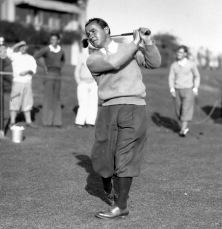The Shot "Heard Around the World" Still Echoes at the Masters
The Shot “Heard Around the World” Still Echoes at the Masters
Now that we are back at the Masters for 2014, it is time to remember the great players, great shots, and great Masters. This is the one tournament of the year that brings golf home to the masses. And much of it is because of Gene Sarazen, the second Masters held in 1935, and the “shot heard around the world”.
Gene Sarazen is, in many ways, the most unlikely of golf heroes. In fact, his name wasn’t even Gene Sarazen. He was born Eugenio Saraceni, but changed it because, as he said, his real name sounded more like that of a violinist.
Gene Sarazen sounded like a golfer.
Sarazen came into golf, as did so many early professionals, from the caddie ranks. At the age of eight, the son of a struggling carpenter from Harrison, New York, he took a job caddying at Larchmont Country Club in Westchester. It was his way of helping the family make ends meet. He wasn’t thinking about playing the game. As he said, “In those days only brokers and bankers played golf.”
Three years later he quit school and started caddying full time at the Apawamis Club in Rye, New York.
Then at the age of 19, Sarazen turned professional and a year later won the U.S. Open held at the Oakmont Country Club, near Pittsburgh. He was the first professional to shoot 70 while winning an event.
But he had problems as a player. He had no short game, especially out of bunkers.
However, with a touch of creative genius, Sarazen solved that problem, and it is perhaps his greatest contribution to the game. He invented the sand wedge. Watching the way planes lifted off the ground, he thought of welding solder onto the back of a club, building up the flange so it sat lower than the leading edge when soled. The flange, not the leading edge, would contact the sand first, and explode sand as the shot was played. He kept his ‘invention’ secret going into the 1932 British Open at Prince’s Golf Club and walked away with the championship.
Still, Sarazen had more in store for the golfing world.
At the ’35 Masters, he was playing the 15th on the final round and trailing Craig Wood by three shots. When he reached his drive on the par, 550 yard, hole known as Firethorn, he saw it was a tight lie and he pulled from his bag a newly designed four-wood, called a Turfinder, which had a hollow-back sole that enabled Sarazen to go down after the ball. He played the ball back in his stance and toed the head. And as he came down, he cut slightly across it to give the shot additional loft.
Of that fairway wood, Sarazen would later say, “From the minute I hit the ball there was a feeling in my system that it was going to be close. The ball went straight for the hole, about 235 yards away. It didn’t carry the green. It carried short and rolled about 15 feet to the cup and in. The only way I could tell if it dropped or not was because 20 people around the green all jumped up and yelled like hell, and one of them was Bob Jones. He had walked back down from the clubhouse to see (Walter) Hagen and me finish.”
But the man who made the feat international news, and, in turn, announced this new tournament in Augusta, Georgia as a major event, was sports writer, Grantland Rice, when he defined the 4-wood double-eagle the next day in his column as the “shot heard around the world.’
Rice went on to write: “A gallery of more than 2,000 was banked back of Sarazen and packed back of the green….the ball left the face of his spoon-like a rifle shot. It never wavered from a direct line to the pin. As it struck the green, a loud shout went up, and then suddenly turned into a deafening reverberating roar as the ball spun along the way and finally disappeared into the cup for a double eagle.”
Rice, according to Sarazen, missed the number of patrons (as they call spectators at the Masters) by 1,978.
Still that ‘shot’ established Sarazen as the number one player in the world and created the Masters.
Over the course of his career, Gene Sarazen would win 39 times on the PGA Tour, including this Masters, the U.S.Open twice, the British Open once, and the PGA Championship three times. Then, in 1973, to top off a long and brilliant career for this former caddie, he finished with a hole-in-one at the British Open at the Royal Birkdale Golf club in Southport, England, proving with his life that golf wasn’t just for brokers and bankers.
This is such an inspiring story, particularly because we witness a young man rise from the depths of caddying to become a golfer. It happens so seldom that it is good that the saga is finally told. If a caddy can do it, so can we all!
a good story well told!! It reminds me of the time I scored a hole-in-one on the 14th hole at Burke Golf Club! There I was……
My brothers Dave and Pete and I started out as caddies at Brookhollow in Dallas in the late 1940’s.
Dave became an archivist/historian/curator
Pete could sing, dance, remember all of Elvis’s songs perfectly
I emerged a poet, ended up an old man remembering my bro’s.
I love this entry. Not one of we boys became golfers, but….